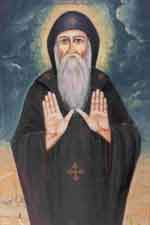 His Character:
His Character: One of St. Macarius’ great features was “wisdom”. His friends and close kin used to call him “Pidar Yougiron” which meant the “old young man” or “the young man with the elders’ wisdom.” He also had the ability to disclose matters, which appeared as a spirit of prophecy and so they called him, “the prophet who wore the spirit,” which meant the carrier of the Holy Spirit.
He was forgiving and consoling. With the strength of the Spirit, he was able to lead all levels of people to Christ. Among the disciples he led, were the harshest, such as Moussa the Black, as well as the most compassionate, such as the beautiful boy Zakareya and Abulinaria, the Sinclitic nun (who is called “the one raised by the Saints”) who was the daughter of one of the royal palace’s men.
St. Macarius’ face used to be enlightened with grace in an amazing way to the extent that many fathers testified that his face used to glow in the dark; and thus appeared his name as “the glowing lantern.” This description was transferred to his monastery, and thus it was called “the glowing lantern of the wilderness” or “the glowing monastery,” which meant the place of high wisdom and constant prayer.
The greatest characteristics of all was the Divine power St. Macarius was possessed, which was called “the Cherubim,” which was the source of his strength, inspiration, good disposition, and his fearful power over evil spirits.
St. Macarius goes to Shehit once again:
St. Macarius was leading the holy liturgy in the town of Shebshir, Monofeya Province, northern Egypt, where he was assigned as priest, when he had a vision. That is how he went to the desert of Shehit, (now called Wady El-Natroon (the Valley of the Neutron), which was not a strange place to him. He used to visit the desert during his childhood with the camel carriages his father, the then village’s minister, owned. The camels used to carry neutron from Wady El-Natroon to Tarnout (now called El-Terana) through the Nile. Neutron was then shipped for exportation to France and other countries.
While St. Macarius was praying, he saw the Cherubim surrounded with a joyful light coming to encourage him. Overjoyed with this vision, St. Macarius walked until he reached the wilderness of Shehit. He stood confused, and prayed to God to show him a good place to live in. The Lord answered his prayers through the Cherubim, saying: “It is your choice. Here is the entire wilderness before you. I do not wish to command you to live here or there so that you would not feel bored or persecuted, then leave the place I chose, and your break the command and sin. Where you live is your own will.” The Cherubim encouraged him by saying; “according to the Lord command, I will be with you at all ties.”
At that time, St. Macarius was about 40 years of age, born in the year 300 A.D. and thus the beginning of his solitude in the wilderness of Shehit was around the year 340 A.D.
The beginnings of the Monastery of Paramus
St. Macarius had chosen the place that is now called the Monastery of Paramus. He dug a hole in the rock for himself and started to worship the Lord with great austerity. Soon, his fame spread and many visitors came to see him and loved him a great deal because they sensed his fatherliness, wisdom and the grace that was in him.
According to scripts, St. Macarius stayed in that place for twenty years until the Monastery of Paramus was completed and filled with monks who lived in holes around the main church, which had not yet had walls.
During that period, St. Macarius visited St. Anthony twice, once in the year 343 D. and the other in the year 352 A.D. He learned from St. Anthony all his virtues and teachings. St. Anthony gave him the old “Eskim” to wear as well as his walking stick. This was a prophecy that St. Macarius was to be the successor of St. Anthony in leading monasticism. St. Anthony testified that St. Macarius was accompanied with a great power, when he told him, “A great power emerged from those two hands.”
St. Macarius also visited Nitria region many times, to lead the monks under St. Amoun to prayer in their church. He also sought their communion in the Lord’s body and blood since there was no church built yet in Shehit until St. Macarius had made his second visit to St. Anthony in 352 A.D.
